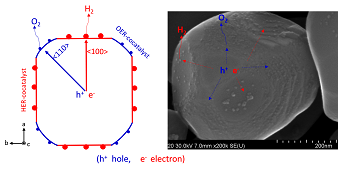Jun
23
Water Splitting With UV Nears 100% Quantum Efficiency
June 23, 2020 | Leave a Comment
Shinshu University scientists have successfully split water into hydrogen and oxygen using ultra violet light and meticulously designed catalysts. They accomplished this at the maximum efficiency, meaning there was almost no loss and undesired side reactions. This latest breakthrough in solar hydrogen production could become scalable, thus economically viable hydrogen production could be more likely, suggesting a way for humanity to grow a substantial hydrogen fuel market.
Water splitting using catalysts and sunlight, called photocatalysis, has been a promising method of achieving solar hydrogen production for decades. However, most previous attempts only yielded an external quantum efficiency of less than about 50% representing the difficulty in efficient catalyst design for real world use. The catalyst needed to be designed better so every absorbed photon from the light source is used to make hydrogen. The key to improving efficiency was strategic placement of the co-catalysts and preventing defects in the semiconductor.
The research paper has been published in Nature.
Tsuyoshi Takata of Shinshu University et al. broke through new frontiers in hydrogen production by using aluminum-doped strontium titanate as a photocatalyst, whose properties have been extensively studied and therefore the best understood. They choose co-catalysts rhodium for hydrogen with chromium oxide, and cobalt-oxide for oxygen, by fine-tuning them to engage in only desired reactions. This method made it possible for the reaction to have no recombination losses.

Structure and function of the developed photocatalyst for efficient water splitting. Image Credit: Shinshu University. Click image for the largest view.
These new findings open the doors to achieve scalable and economically viable solar hydrogen production. These design strategies succeeded in reducing defects that led to near perfect efficiency, and knowledge obtained will be applied to other materials with intense visible light absorption.
More work is still needed before people can fuel cars on hydrogen. Because this study focused on the use of ultraviolet light, abundant visible light from the sun remained unused. However, this great breakthrough has made that possibility no longer too good to be true, but in theory, just a matter of time. Hopefully it will encourage scientists, researchers and engineers to engage in this field, bringing the use of solar hydrogen power that much closer.
This is an example of excellent work that through careful design has been able to nearly fully close the gap in the UV spectrum in solar hydrogen. Just what the rest of the earth’s surface light spectrum is used for remain to be seen. Perhaps one day we’ll see a solar cell stack that uses all of the incoming light and produces more than one resource product.

